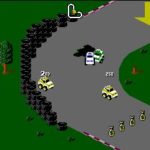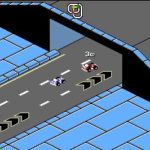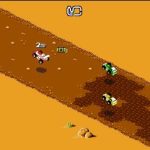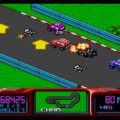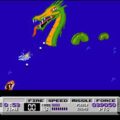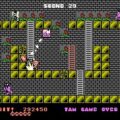Developer: Rare Publisher: Tradewest Released: 12/11/92 Genre: Racing
R.C. Pro Am is a game that I have a love/hate relationship with. The controls and overall feel of the game is great. But the insane rubberband AI completely ruins it after about ten races in my eyes. One would expect that Rare would release a follow-up for the SNES when the system was on fire in 1992. Instead R.C. Pro Am II hit the NES instead. While a little disappointing it does correct most of the flaws of the original and is a much better game and one of the better racing games for the system.
For the most part R.C. Pro Am II is very similar to its predecessor. Races take place using the same isometric viewpoint against four competitors. The structure of progression is a little different however. Rather than awarding trophies based on position you instead gain points. Unlike say Wave Race 64 there is no minimum threshold needed for progression; so long as you come in third place you will continue. Whether it is better comes down to personal preference.
In addition to points you also earn cash and can also find more on each track. Money can be spent on upgrades between races, replacing the random parts system of the first game. They cover the same categories; motors will increase top speed, tires offer better grip, and you can buy weapons like missiles, bombs, and nitro. The impact is almost immediately tangible and near mandatory. After a few races you will notice the computer cars steadily going faster and without better motors it is hard to keep up. The handling with new tires is probably my favorite as they give a level of control that is unprecedented in a NES racing game.
Weapons have undergone a similar slight change. Missiles and oils slicks work exactly the same but there are plenty of new additions. The freeze beam can be used like the blue turtle shells in Mario Kart to secure a first place win at the last second. Buckshots don’t damage opponents; instead they drop cash. The lamest is the laser which is simply a more powerful missile. The absolute best in my opinion is Nitro. It takes a second to kick in but gives a nice little boost of speed. A nitro boost will allow you to breeze past obstacles like oil and water. But its best use is on hills; a well-timed boost will send you skyrocketing past the competition. The same also applies to the AI and they aren’t shy about doing the same.
There are still plenty of items littering the track. Car parts are still present although they aren’t as prevalent. Stars are ammo for your weapons and random cash peppers each track. Everyone who played the original will remember collecting the NINTENDO letters to earn new cars. They will also remember the computer would also gain the same vehicle as you, defeating the purpose of earning a better car in the first place. That is not the case this time around. If you collect all the letters that spell “PRO AM II” first you can upgrade before the computer. That’s right, they can collect their own player specific letters as well. The nightmare scenario of the computer receiving a souped vehicle before you is very real.
In spite of all the tweaks and additions to the underlying formula the biggest upgrade is in the track design. The biggest criticism of the original was that every track looked near identical. R.C. Pro Am II has three different terrains: country, city, and off-road. Beyond their visual look each brings new hazards into play. In the country massive hills and rivers litter the track. In the city overpasses obscure your view and snow will slow you down. Oil, rocky terrain, and planes on bombing runs make the off-road areas more of a challenge. I especially like the addition of hills and ramps. The flat courses of R.C. Pro Am made the game very boring after a while. The thrill of using a nitro before a giant ramp and passing everyone never gets old and is a vital strategy to winning first place.
The rubberband AI of the first game returns but is not as egregiously bad. You can still build a lead and keep it to an extent. But the computer will eventually catch up, even with a lesser truck. To my knowledge though there is nothing like the massive speed boost that would cause the yellow car to lap you multiple times. But the difficulty does get to a point where you need to hit every speed bumper and avoid hitting walls frequently to place in the top three. Ideally they should have done away with the rubberbanding but it is manageable at least. But it could have been better.
In Closing
R.C. Pro Am II is an excellent game that fixes nearly all of the flaws of the original and is enjoyable from start to finish. Tight controls, better track design, and multiplayer give it longevity and a place in any NES fan’s library.


